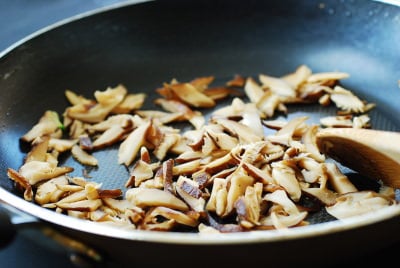Korean temple cooking is primarily based on seasonal plant-based ingredients. As such, temple dishes are vegan. These simple zucchini dumplings are a summer favorite at temples in Korea.
I recently had the opportunity to interview with a Korean TV network, BTN – Buddhist Television Network. BTN sent a team of four people to travel and film a documentary about Korean temple cuisine in different parts of America. They asked me if I could make some temple dishes and share my thoughts on the food and cooking style. I had a great time cooking and filming a small part of the program while sharing the dishes with the friendly crew.
Korean temple food
Temple food has been increasingly popular in and outside Korea by health conscious people, as well-being, healing food regardless of religious backgrounds. I was very glad to have this opportunity to learn more about it.
While there is so much to talk about the 1700-year-old Korean temple food (사찰음식), here are five basic things you should know:
- Korean temple cooking is primarily based on seasonal plant-based ingredients, which are either organically grown in temple grounds or harvested from nearby fields and mountains. As such, temple dishes are vegan!
- There are 5 forbidden vegetables, called oshinchae (오신채). They are garlic, scallion, onion, buchu (부추) – garlic chives, and dalrae (달래) – wild rocambole/small wild onion. These vegetables are considered stimulants which hinder spiritual meditation.
- Temple dishes are lightly seasoned only with natural seasonings, so they generally have a mild, clean taste. Temple cooking uses a wide variety of natural flavor enhancers such as mushroom powder, lotus root powder, perilla seeds, etc. as well as temple made Korean traditional fermented condiments such as soy sauce (aka jib ganjang/soup soy sauce), doenjang (soybean paste) and gochujang (red chili pepper paste).
- Because they have to work with limited ingredients, temple cooks are experts on identifying edible wild plants, creating many different dishes with limited ingredients, and preserving/pickling vegetables when they are in season for later use.
- In Buddhist temples, cooking and eating is considered spiritual meditation. The food is made with care to nourish the body, mind, and soul of those who eat it. Food is considered medicine.
Hobak mandu (zucchini dumplings)
This dumpling recipe made with summer zucchini was recently featured on BTN as a favorite summer dish at Bongnyeongsa, the oldest temple in Suwon, Gyeonggi-do. I was totally intrigued by the simplicity of this recipe, which was made with only 2 filling ingredients, one of which is actually optional. Bongnyeongsa boils these dumplings, cools in cold water, and serves cold.
Let me tell you — what a refreshing change this was from my usual mandu recipes which involve several filling ingredients and lots of chopping and squeezing! It is so easy to make, guys! The best part of it is the nice and clean taste which allows you to simply savor the natural flavor of the sweet summer zucchini.
The mushroom complements the zucchini with a bit of earthy flavor and meaty texture.
Watch how to make it
More Zucchini Recipes
Hobak buchim (zucchini pancakes)
Hobak bokkeum (stir-fried zucchinis)
Hobak jeon (pan-fried zucchini in egg batter)
Gochujang jjigae (spicy stew with zucchinis)
For more Korean cooking inspirations, follow along on YouTube, Pinterest, Twitter, Facebook, and Instagram.

Ingredients
- 24 dumpling wrappers
- 2 zucchinis about 10 ounces each
- 1 teaspoon salt
- 4 dried pyogo beoseot, 표고버섯 (shiitake mushrooms) soaked (or use fresh) - optional
- 1/2 tablespoon soup soy sauce, 국간장 (or 1 tablespoon regular soy sauce) or 1/4 teaspoon salt
- sesame oil
Instructions
- Cut the zucchinis into thin disks and then into matchsticks. If the disks are big, cut in half before cutting into matchsticks. Lightly sprinkle with salt (about 1 teaspoon), and let sit for about 15 minutes until wilted and some liquid is released. Gently squeeze the liquid out from the zucchini.
- Place one heaping teaspoonful of the filling on a wrapper placed on your palm. Wet the edges of the wrapper with water, fold the wrapper and seal tightly (pushing the air out with your fingers) into a half-moon shape. You can pinch one side of the wrapper to form pleats. Repeat this process until all the filling/wrappers are used.
- Remove and serve cold with a dipping sauce (2 teaspoons soy sauce, 1 teaspoon vinegar, and 2 teaspoons water) if desired.
Notes
Regardless of the shape, make sure to seal tightly as the dumplings will be boiled. Adapted from Bongnyeongsa Temple Recipe
































